#into which of these species are surface active and surface active species in general
Text
im feeling chatty.
i dont currently plan to get more isopods but dreamy species (that are actually within reach. So none of those adorable spiky ones like shiny gators, ancient gators, thai spikies... Just absurdly expensive and hard to get) are uhhhh:
armadillidium cf espanyoli “marbelized”

(pic source) i just loooove the patterning its so pretty ive seen some really stunning ones in pictures too. theyre really tiny apparently. i already think my cappuccinos are tiny and theyre like twice the size of the marbles from what i can tell. itd be cool to have more Sizes u kno. these are the most tempting to me like if i was looking for another species to keep or if i had more room. itd definitely be these. great combo of beautiful pod and not so expensive or notoriously hard to work with or anything.
porcellio expansus “orange”
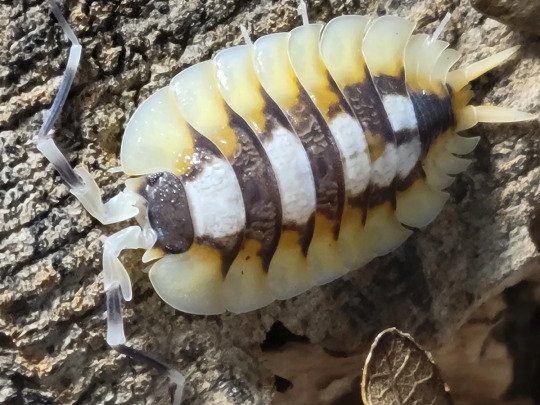
(pic source) theyre BIG fuckers!!!! not as big as hoffmanseggi but preddy big and very flat and i like their big exopods/uropods (?) (the funky tail things the guys have longer ones of) allso. isolated from the general porcellio expansus from spain which is sometimes calld the beetlejuice isopod and i have brain rot. They do have such cute little striped black and white antennae though, see?
A strain like autumnal equinox is also tempting but..... idk
cubaris sp “lemon blue”
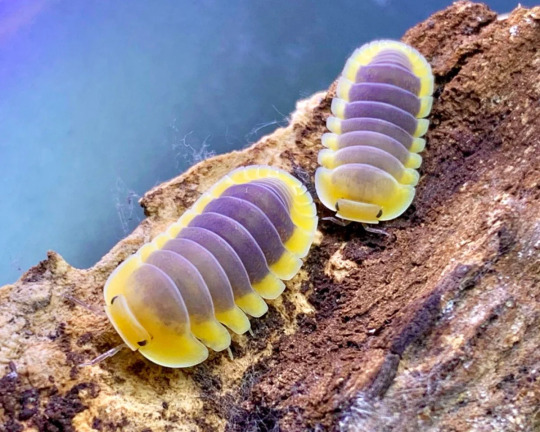
(pic source) arent they stunning. ok so i want one of the yellowy ones i think theyre cute but it could be lemon blues it could be jupiters it could be some rendition of the bees. rubber bees, emperor bees, bumble bees.
armadillidium vulgare “gem mix”

(pic source) this is actually a really commonly available mix and was almost my first set before i got that absurd deal on my cappuccinos. I just love how rich and deep the colors are and they all complement each other so well. there are other mixes of other species like ‘lotto ticket’ and ‘party mix’ but the gem mix is so pretty to me
honorable mentions
armadillidium nasatum “peach” - absurdly cute to me. such a pretty color and such nice markings. not SUPER up my alley in terms of what id want to keep but just so nice to look at. if i had space and saw a good deal. itd be tempting.
cubaris sp. “pak chong” - they are also. so cute. they were actually one of the other ones i was considering as my first isopods, the reptile store in my area has some (as well as that gem mix) but i had been worried they would be too hard to care for (and then i went for the theoretically Harder to care for cappuccinos anyway so i had to level up my isopod keeping really fast and early for those little thangs) anyway i like their little red face and butt.
venezillo parvus “kumquat” - maybe i just like the food names especially. bc i have cappuccinos and chocolate zebras at home. but also a lot of morphs have food names. They are just so so cute conglobated and they are teeny tinys. i like their coloration and markings. this section is kind of repetitive now that i think about it
cubaris sp “white shark” - literally would be on the list but theyre just so tinys. idk why but them being tiny seems like a big L in this case but in other cases a species is tinys and im like. epic....
thenks for reading :P :)
#i just wanted to ramble and put pics of isopods and look up pics of isopods. thanks for paying attention to me :D#by that i mean. thanks for letting me post this. you dont have to read it#posts#bugs tw#all this said. if a good spiky isopod deal was available you KNOW i would drop everything to make space#have you seen those things. theyre so cute its stupid.#plus they generally have patterning more like what i seek out in pods. the ones i listed at the top at least.#i like colors that feel like they could be natural but are also really deep and vibrant or have a lot of contrast.#like lemon blues are a pretty Alien looking isopod in a very cool way and i think theyre extremely pretty thats why id want like. one yellow#species for that hint of Brightness. in my enclosures. but id only really want One of that like. category#but also. my zebras are SO good and its abslutely because theyre just really surface active. so i should probably care more and look more-#into which of these species are surface active and surface active species in general#bc like. i LOVE my cappies. right. but i do not get to fucking see them most of the time#isoposting
1 note
·
View note
Text
Alien Questionnaire - A Biological Perspective
A while ago, somebody linked me a very comprehensive worldbuilding questionnaire. For most aspects of a fictional society, it was great, but I noticed it assumed that anyone using it was making up a fictional human society, or at least a society of beings very similar to humans. As such, there was almost nothing in the biology department, which to me is one of the best parts! Thus, this questionnaire was born.
These questions are designed to help people worldbuild from a biological foundation. As such, the questionnaire only touches lightly on other aspects of a fictional society, and is more of a jumping off point. I wrote it with the aim of using it to develop aliens, but it should be suitable for any project with non-humanoid species, such as sapient terrestrial animals.
Have fun! I'd love to see your answers :)
------------------------------------------------------------------------------
General Anatomy
How many limbs do they have? Do they have limbs at all?
What are their primary manipulators? Where are they located? How does this affect their tool use, building ability, etc?
What kind of body covering do they have, e.g. hair, scales, feathers? How do they clean it? Do they shed this covering constantly, or all at once at certain times?
Can they maintain a constant body temperature? If not, how do they deal with changing environmental temperatures?
What kind of habitat do they live in? Both specific habitat, and broader such as on land vs in water.
What adaptations do they have for living in this habitat?
What kind of creature did they evolve from?
What are the similarities and differences to their closest living relatives?
What resource(s) is the most necessary and urgent for them? E.g. for many animals, but not all, it’s water.
What are some common mutations? E.g. eye colours, ability to digest lactose in humans.
What injuries or illnesses are considered disabling?
How is their healing ability? Can they regenerate? If they can, is that limited to certain body parts or a certain number of times?
Senses
What senses do they have? E.g. sight, smell, electroreception, etc.
How good are those senses?
Which of their sense/s do they use the most in everyday life?
How might this choice of sense impact the way they interact with the world?
Can they detect things that Earth creatures cannot? If yes, how and why?
Movement
How do they move? Do they walk, crawl, fly, etc?
If they have multiple modes of movement, which is preferred, and why?
Which part/s of their body do they use to move?
What is their speed and endurance like?
How agile are they?
Do they rely mainly on their own bodies for travel, or do they use pack animals and machines?
How often do they move around? Are they mainly sedentary, do they move a lot within a set area, do they migrate, etc?
Do they have different levels of mobility depending on age, sex, or other biological group? E.g. young barnacles are able to swim, while adults are anchored permanently to a surface.
Reproduction and Lifecycle
How many sexes are there?
Are there differences between the sexes (ignoring the reproductive system)?
Are there different castes, such as in honeybees or naked mole rats? If so, what is the function of each caste?
Are differences in sex or caste used to justify discrimination or hierarchy? How might these ideas differ in different populations?
Do they have a concept of gender? If so, is gender affected by sex, caste, or some other factor?
How do they attract a mate? Do they release a chemical into the air, do an elaborate display, etc?
Does one individual try to actively woo another, or is courtship more mutual?
What do they find attractive in members of the same species?
What is the usual reproductive partnership? E.g. two individuals, one main reproducing individual with a harem, no set partner, etc.
How long do they live?
How are young brought into the world? Live birth, eggs, spores, etc?
Is producing young a painful, dangerous process, or is it easy?
How much parental investment is there? Are there many young with little investment, or few young with a lot of investment (r vs K strategy)? Or is it somewhere in the middle?
How many offspring are produced at a time? Think about how attitudes towards children may differ between a species that produces one or two, and a species that produces dozens or even hundreds at a time.
How do they grow? Are they born looking like miniature adults, gradually growing bigger? Do they have specific phases of high growth, like puberty? Do they have a larval phase, metamorphosis?
How self-sufficient are they as young? Can they move around and feed themselves as soon as they are born? Do they require parental care?
What is the usual structure of childcare? Single or multiple parents/related individuals? Communally raised?
Is sex purely for reproduction, or does it serve other purposes?
What kind of sexuality is considered the norm? This doesn’t just refer to same/other sex pairings, but the culture around sex in general.
Diet and Foodchain
What is their diet? Are they carnivores, omnivores, frugivores, insectivores, etc?
Do they feed off an unusual source, for example rocks, metals, or (in appropriate settings) something like magic or souls?
What physical adaptations do they have for this diet?
Is their diet very restricted, or can they have a wide range of foods?
How often do they eat? What is the culture around mealtimes, if any?
Are they prey for other organisms? For each other?
If they are, how do they deal with it? Do they fight back, have barriers, or do they accept it as a part of life?
If they are hunters themselves, what is their attitude to killing other organisms? Are they respectful? Prideful of their kill? Is it completely trivial?
If they are hunters, how do they hunt? Are they solitary or packhunters? Are certain members of the group designated to hunt?
Are the results of foraging or hunting shared, or is it everyone for themself?
Are they parasitic, parasitised, or in a symbiotic relationship with any other organisms?
Body Rhythms
How often do they sleep?
What time of the day are they most active? Are they nocturnal, diurnal, crepuscular?
Do they generally sleep for one long period a day, multiple shorter periods throughout, or something in between?
Do they sleep to cope with extreme temperatures or bad conditions, i.e. hibernate or aestivate?
Do they have any biological processes that disrupt their life e.g. moulting, reproductive cycles, etc?
If yes, how does their society accommodate for these processes? Does it accommodate them at all?
Communication
What is their main method of communication? Sound, visuals, scent, etc? Think about their main sense and how this would affect communication.
What is their body language like? What small moving parts might aid their body language?
If they have multiple methods of communication, are they all given equal weight, or is one considered higher than others?
Society
How sociable are they?
If social, what is the usual social structure?
Are there hierarchies? How strict or relaxed are the roles?
How are disputes usually settled? Is it more common to be violent or appease the other party?
If not social, what is the reaction to being with other individuals? Do they become aggressive or stressed? Do they tolerate each other?
What is the usual size of a community? Do they have communities at all?
Do they have an in-group vs out-group mentality? If so, how strong is it? This generally relates to how scarce or plentiful resources were during their evolution, and how territorial their ancestors were.
What kind of bonds do they form?
On the spectrum of individualistic to community-oriented, where do they fall?
Do they have a strong sense of personal identity? Think about how this might tie in with the previous question.
What are the main things they derive identity from? Occupation, gender, family ties, etc?
Do they have names? If yes, how are these names formed? Are they given by another party or chosen by the individual?
Have they domesticated any creatures? If so, what do they use these creatures for?
Do they have any unusual relationships with other creatures on their planet (beyond predation, parasitism or mutualism)?
Do they produce art? What are their main forms of artistic expression? Think about how this will be linked to their main sense(s), communication method, and/or primary manipulators.
------------------------------------------------------------------------------
GLOSSARY
Primary manipulator: Main body part used to manipulate objects, e.g. hands in humans, trunks in elephants, feet in parrots.
Sedentary: Inactive, staying in the same place.
Caste (reproductive): A group within a species with differences in body type and reproductive ability.
Symbiosis/Mutualism: Interactions where both parties benefit, e.g. cleaner fish getting a meal in exchange for picking irritating parasites off larger fish.
Aestivate: To become inactive during hot or dry periods, usually involving being sealed in mucus or soil e.g. lungfish, snails.
Reproductive cycle: Regular hormone fluctuations that affect an animal’s fertility or attitude towards breeding. The cycles can range from months to years and can include things such as antler growth in male deer, heat cycles, and menstruation in humans.
#worldbuilding#biology#zoology#speculative evolution#speculative biology#spec evo#spec bio#alien#questionnaire#xenobiology
2K notes
·
View notes
Text
Wet Beast Wednesday: electric eel
Prepare to be jolted this Wet Beast Wednesday as we dive into the shocking world of electric eels. The fist thing to know about electric eels is that the name is a lie. Not the electric part, that's true, but the eel part. Despite appearances, electric eels are actually knifefish, a group of freshwater fish that are more closely related to catfish and piranha than to true eels.

(Image: three electric eels swimming in an aquarium. One in front is seen in profile. It is an elongates, slender, brown fish with tiny pectoral fins and a long anal fin that runs under most of the body. End ID)
There are three species of electric eel, though they are so similar to each other that they were previously classified as one species. The species are Electrophorus electricus, Electrophorus voltai, and Electrophorus varii. The main difference between the species are in the shape of the skull. All electric eels are elongated fish that are cylindrical at the front and flattened vertically at the tail. They have no pelvic or dorsal fins and the tail fin is small and fused with the anal fin, which runs across most of the body. The anal fin is the primary means of locomotion for the eels. By undulating the fin in a wavelike motion, the eel can swim forward, backward, or hover in place. The body of the eel is scaleless, instead bing covered in muddy brown skin. Electric eels grow throughout their entire lives and grow new vertebrae as they get longer. The largest species, E. electricus, can reach 2 meters (6.6 ft) long and weighs up to 20 kg (44 lbs). They are obligate air-breathers, being incapable of obtaining enough oxygen through their gills to survive. Instead, they must surface every two to ten minutes to breathe. The inside of the mouth is wrinkly and heavily vascularized, resulting in a high surface area that can absorb oxygen as long is it stay wet. The floor of the mouth can flex to draw air in and then it is forced out through the gills. Carbon dioxide is excreted through the skin. Electric eels have poor eyesight, but have electroreception and very good hearing thanks to Webers apparatus, a set of tiny bones that connect the inner ear to the swim bladder. The apparatus amplifies sounds that the ear would not be able to detect on its own.

(Image: a close-up of an electric eel's head. It is round and brown, reminiscent of a potato in texture. The mouth is located on the frond and is closes, with no visible teeth. Tje eye is very small and pale blue. Across the head are sensory pits that look like small holes. End ID)
All of the vital organs of the eels are packed into the first fifth of its body length. The rest of the body contains the electric organs. Keeping the vital organs in the front of the body isolates them from the electric organs, preventing the fish from damaging their organs while generating electricity. The electric organs take up so much more space because they need to generate very powerful electric shocks. Most fish that hunt with electricity are saltwater species as salt water conducts electricity much better than freshwater. Because electric eels are freshwater fish, they need to generate much more powerful shocks to effectively hunt other animals. E. voltai can produce a maximum recorded 860 volts of electricity, the highest of any animal. Electric eels are electroreceptive, able to sense electric fields in their surroundings. Electroreception is divided into passive (animal senses electric fields of others) and active (animal generates its own electric field and can sense distortion in that field caused by other objects or animals). Electric eels are active electroreceptors. They sense changes in their electric field using sensory pits on the head that are derived from the lateral line system that all fish have. Electric eels have three electric organs: the main organ, Sach's organ, and Hunter's organ. The main organ sits in from of the Sach's organs while the Hunter's organ sits beneath both. The organs are derived from muscles and consist of stacks of structures call electrocytes, which are made up of specialized cells. When the brain sends a signal to the electric organs to produce a shock, special ion channels pump sodium ions into the cells while different channels pump potassium out. This creates a sudden difference in electric potential, which is what generates the shock. Producing electricity is a costly process and the eels need rest and nourishment between multiple successive shocks. The main organ generates the powerful shocks used to stun prey while the Sach's organ creates weaker shocks used for active electroreception. Hunter's organ appears to support the other two.
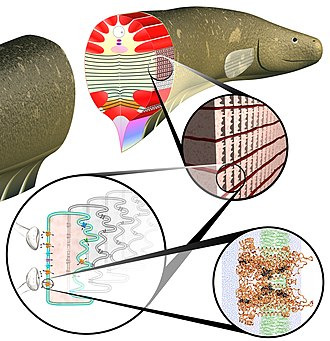
(Image: an artistic depiction of a cross-section of an electric eels, showing the structure of the main electric organ. From there, the image is zoomed in on multiple times, showing the the structure of the electrophytes, the protein channels, and the structure of the proteins involved in generating electricity. End ID. Art by Daniel Zukowski)
Electric eels are found in northern South America and the ranges of the three species generally do not overlap. They prefer muddy bottoms or swampy areas. The terrain of their territory changes quite a bit through the year. In the wet season, water levels rise, flooding sections of forest and grassland and connecting streams and ponds. In the dry season, water levels drop and many streams and ponds are isolated. These isolated bodies of water become warm, low-oxygen areas where fish that rely on gills are at a disadvantage while air-breathing fish like the electric eels can thrive. Electric eels are nocturnal predators that detect and stun prey through their electric abilities. Their diet consists mostly of fish, but they will take just abut anything. While mostly solitary, E. varaii have been observed coordinating with each other to hunt schools of tetras. When the electric field generated by Sach's organ is disturbed by another animal, the eel will use the main organ to produce a strong shock to stun the prey. Stunning can be done from a distance, but is more effective if the eel makes contact with the other animal. An initial shock may be used to temporarily immobilize prey long enough for the eel to contact it and release a second shock. Some sources propose that the eel can use its shock to forcibly contract muscles in other animals, either immobilizing prey or forcing prey to move, making them easier to sense. Where or not this is something the eels can actually do is up for debate. Electric eels also use their shocks to deter potential predators. When feeling threatened by something on land, the eel can leap out of the water to make contact with the threat and shock it. Very few animals prey on electric eels, but known predators include caiman, alligators, and piranha.

(Image: six frames showing na electric eel in captivity responding to a perceived threat (a fake caiman head) by partially leaping out of the water and contacting the head to shock it, before returning to the water. End ID)
Electric eels breed in the dry season. Males will use their saliva to glue together mud and sand into nests where the females lay their eggs. The male then fertilizes the eggs by releasing sperm onto them. The females may lay eggs multiple times during the breeding season and can lay up to 1200 at a time. The male stays by the nest to guard the eggs and hatchlings for up to four months. The lifespan of electric eels is in question, but captive specimens can live for up to 20 years.

(Image: an electric eel resting on a pile of wood next to some rocks. End ID)
All species of electric eel are classified as least concern by the IUCN, meaning they are not at threat of extinction. Threats to them mostly consist of pollution and habitat loss. Studies of the electric properties of the eels have lead to multiple discoveries and inventions. In particular, Luigi Galvani was inspired by studies on the eels when he invented the battery. Electric eels are also important in the study of the voltage-gated sodium channel. These channels are used to generate electricity, but are also used to trigger the contraction of muscle cells in many species, including humans. It is hard to study the channels in muscle cells because they are found in very small amounts. The electric organs of the electric eel have much higher quantities of these channels, making it much easier to study them. Better understanding of voltage-gated sodium channels could lead to improvements in prostheses and medical implants.
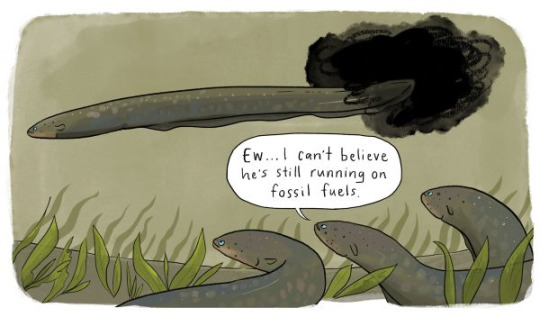
(Image: a cartoon showing an electric eel swimming with a black cloud emerging from its tail. Threee other eels watch from the side, one commenting "Ew... I can't believe he's still running on fossil fuels". End ID. Source)
#wet beast wednesday#electric eel#fish#fishblr#knifefish#freshwater fish#biology#zoology#ecology#animal facts#informative#science
103 notes
·
View notes
Note
suaropods on earth are the absolute upper limit for land vertebrates, but is it because they have four legs? cause i was working on a scifi spec evo idea where the endoskeletal vertebrate-analogs have eight legs and it got me wondering if it means their sauropod equivalents can be even bigger in a similar earth like gravity
If it was just about leg numbers then land mammals wouldn’t be smaller than the biggest dinosaurs
In reality you need specific evolutionary pressures, circumstances, and unique and efficient anatomy to get big.
For sauropods it was entirely due to their internal anatomy. Sauropods are saurischian dinosaurs, which have hollow bones with internal scaffolding that likely made them stronger than if they were solid, as well as a very extensive respiratory system that included numerous air sacks, many of which ran through their bones. This ultimately allowed saurischian dinosaurs to massively cut back on volume and allow them to cool off easier and have more efficient respiration. There’s things we still don’t know about sauropod anatomy though such as how their circulatory systems combated their sheer verticality. Dinosaurs also have unidirectional respiratory systems, which is more efficient than mammalian two way airflow.
For modern baleen whales it has more to do with the aftermath of the last ice age and how it impacted the location of their food (keep in mind this explanation of the evolution of baleen whale size is based on my current understanding and might not be correct). Baleen whales actually used to be much smaller, around bus size. But during and after the last ice age the ocean currents changed and krill populations became concentrated around the poles. Because of this, baleen whales needed a way to eat as much as possible in one sitting and travel long distances efficiently. The easy solution was to get big, which became easier as their predators the macroraptorial sperm whales and Otodus megalodon gradually went extinct. A thing to note however, is that because they need more resources due to their size, the number of baleen whale species is lower than it was several million years ago. Also also, blue whales are getting bigger.
On earth, 200 tons is more or less the maximum size for animals, as the biggest whales, ichthyosaurs, and sauropods got around that size.
There’s more things to note though:
No, higher oxygen levels don’t make things bigger. Not even bugs. Modern arthropods are actually on average bigger than their Carboniferous counterparts, and the oxygen levels were way higher back then. And griffinflies, very active flying insects, lasted all the way into the Permian, when oxygen levels were lower than in modern day.
It’s important to consider what the bones of animals are made of as well as their structure. Different internal structures can handle stress better, and different materials can handle pressure differently.
Eight legs might be too many, as having more legs, while very stable, can be more energy costly. Two legs might not be able to support as much weight as four, but it is more efficient.
A very big thing animals have to fight with when it comes to size is something called the square cube law. Basically as something gets bigger its volume (insides) increase way faster than its outsides (surface area). If you had a 1 centimeter cube and doubled its size, the surface area would quadruple but the insides would increase eight times. But there are ways of combating this such as decreasing volume with things like air sacks or increasing surface area by being very wrinkly (that’s how human brains fit so many neurons!). And because things with a metabolism generate heat, big animals have to combat overheating because they have a lot of insides. That’s why elephants have such big vascularized ears and why their skin acts like a sponge to soak up water.
Also I have no idea how perucetus got so big, that glorious fatass
#ask#questions#anon#anonymous#biology#paleontology#palaeoblr#speculative evolution#speculative biology#speculative anatomy#speculative zoology
188 notes
·
View notes
Photo



The Beautiful Boto
Also known as the Amazon river dophin or the pink river dolphin, the boto (Inia geoffrensis) is a species of toothed whale native to the Amazon and Orinoco river basins in South America. Because they reside mainly in rivers, lakes and mangroves, the boto occupies a large range; nearly 7 million square kilometers (435 thousand square miles). Despite being related to whales and dolphins, I. geoffrensis cannot tolerate saltwater and is only found in freshwater.
The Amazon river dolphin is the largest of the four river dolphin species, weighing in at 98-185 kg (215-407 lbs) and measuring 1 to 2.5 m (4-8 ft) in length. Males are larger than females, and are a bright pink to the females’ dull grey. A significant part of the length comes from the dolphin’s distinctive long snout, which is used to hunt for crustaceans and small fish. The boto’s body is designed to be highly flexible, which comes in handy when navigating through flooded forests. One adaptation in particular that makes I. geoffrensis stand out is the unfused neck vertebrae, which allows them to bend at up to a 90-degree angle. Botos also use echolocation to navigate murky river waters. which is enhanced by the large melon on their foreheads.
Breeding for the pink river dophin occurs between May and June, during the rainy season when flooding is at its peak. Males will fight for access to females, and will also perform courtship displays that involve carrying a number of objects-- like branches, fish, or even live turtles-- and slapping them into the water. Successful pregnancies last 11 months, and after giving birth mothers raise their young in the slow-moving waters of flooded forests. Weaning takes about a year, although mother-child pairs will often stay together for much longer. The average lifespan of the boto can be anywhere from 10 to 26 years, as they have no natural predators.
Outside the mating season, I. geoffrensis is a solitary creature. It’s rare to see groups of more than three at a time, and do not heavily defend set territories. However, they are very curious and have been known to readily approach canoes or play with debris in the water. Individuals have also been seen hunting fish in loose cooperation with other species like giant river otters (Pteronura brasiliensis). The bota is crepuscular, active mainly at dawn or dusk, and generally stay close to the surface of the water. Deep dives are rare, as they can only hold their breath for 110 seconds.
Conservation status: Hunting pressure and pollution, as well as dam building and deforestation, are major threats to the amazon river dolphin, which has been classified as Endangered by the IUCN. Conservation efforts are being made, but the species is difficult to keep or breed in captivity so most work is being done in the wild.
If you like what I do, consider leaving a tip or buying me a kofi!
Photos
Sylvain Cordier
Kevin Schafer
#amazon river dolphin#boto#cetacea#Iniidae#river dolphins#dolphins#toothed whales#mammals#rivers#river mammals#wetlands#wetland mammals#tropical rainforests#tropical rainforest mammals#freshwater fauna#freshwater mammals#south america#central south america#Amazon Rainforest#animal facts#biology#zoology
477 notes
·
View notes
Text
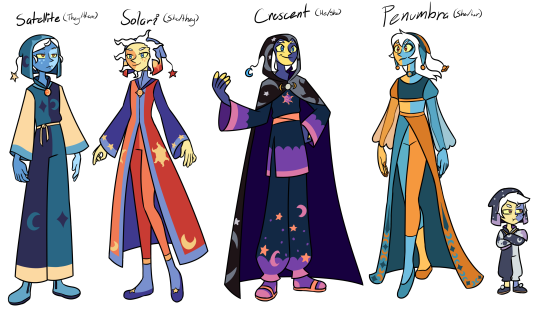
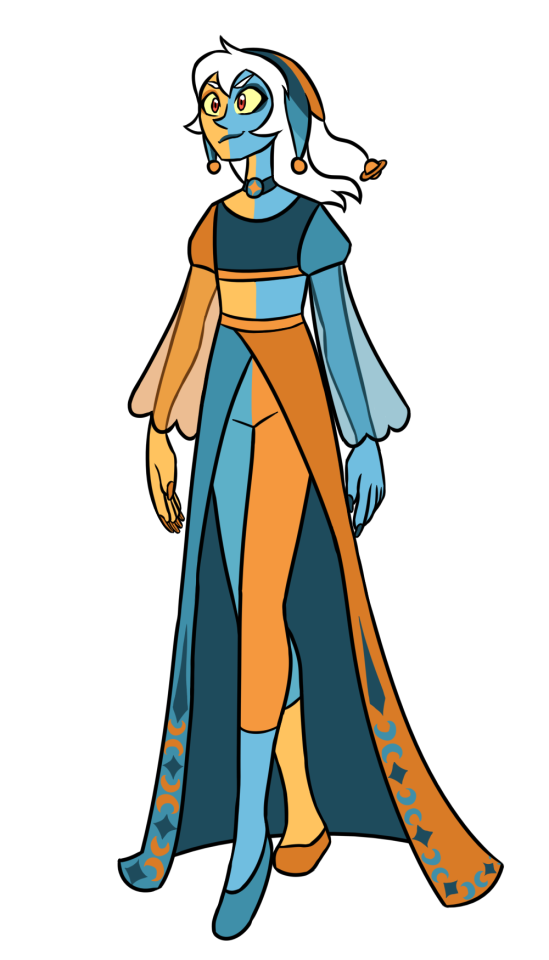

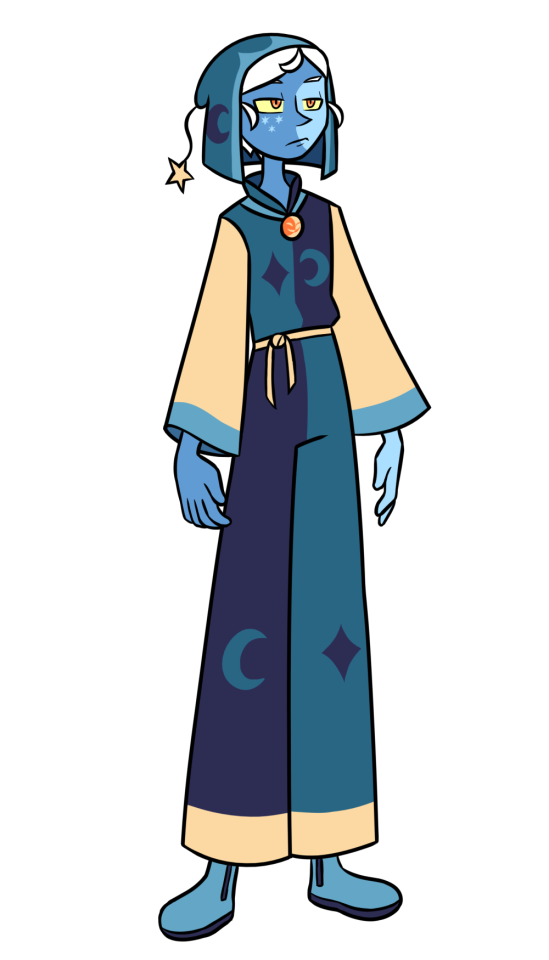

Designed the Archivists. Mainly so I had faces to punch in my mind. But anyways, Penumbra is the eldest, her color scheme was inspired by some pictures of The Pillars of Creation, Crescent is the second oldest, the outside of the cloak is based on. Well you know. And the interior clothes colors are based off of sunsets. Satellite and Solari are fraternal twins and teens* (for their species *This has since been retconned, they are adults CURRENTLY, but were teens during the war against the Titans). Neither it older than the other because these are cosmic entities and I say it can work that way. Their color schemes aren't actually based on anything in particular but after I chose them and laid out the colors I was like "Wow they look like characters on a preschool show that teach you about space" which is sort of ironic.
More info on them under the cut, lil spoiler alert! They are not nice. They are bad in fact.
Penumbra is the one who came up with the idea to send the Collector to the Titan Planet, mainly to see if he was ready to do the work they were all expected to do, partially so they'd all get a break from them. She is also the one who noticed Collector magic doesn't work on Titans. She got along fine with the Collector when she was teaching him things but would get annoyed very easily when he wanted attention in literally any other situation, so she'd send them to play with Satellite and Solari since they were the closest in age to him. She uses she/her but in a nonbinary way, in that I HC all Collectors are cosmic beings outside our scope of understanding of things like sex and gender.
Crescent actually got along the best with The Collector. He would frequently be gone to do things since she is the most active in exploring planets and acquiring specimens, but when he was home she'd love playing with them. He's probably the most outwardly friendly of the Archivists, which you'd need to be when you're constantly interacting with mortals. She's the one who got the idea to get the mortal witches of the planet to kill Titans, using them as easily sacrificed pawns and tools for removing the "threat". He is the one referred to as the Grand Huntsman. You can tell she's fucked up and evil because he wears socks with sandals. (Yeah I double checked the episode with the Titan Trappers and they never once refer to the Grand Huntsman as anything other than that title or "our god" so I'm using she/he pronouns)
Satellite liked playing with the Collector occasionally as they also are easily bored, but Penumbra sending him to always play with them and Solari easily wore their patience thin, so they'd disappear to do "errands" or "chores" or because they were "tired" when it was really just an excuse to leave him with Solari. If they were forced to interact they would easily lose their cool and yell, at the Collector (initially) or in general (after getting in trouble for yelling at him too much), until he was allowed to leave. Despite their surface affect of cool apathy, they're a hot head. Satellite was the one who got to tell the Collector that he should go play with the Titans.
Solari very actively didn't like being around the Collector. Her brand of being "nice" for his sake would be a constant stream of passive-aggression and cold sarcasm, sending them to do pointless chores or activities, scavenger hunts, etc, anything to get him away from them. If they had to interact for some reason, she would do things like play a game called "shooting star" where she would pick him up and magically throw them as far away as possible into space. She's gotten in trouble for it before when they launched him so far they weren't able to return for nearly an hour (after which everyone had to go out looking for him). The Collector did enjoy this game, because little kids just like being thrown around in general, except for the time everyone had to go looking for him because he was launched too far and couldn't figure out where to go to get home.
#toh#the owl house#toh the archivists#the archivists#toh the collector#the collector#toh collector#insanelyadd#toh spoilers#owl house spoilers#should I tags this as original characters#since they're based on existing characters that just don't have faces or personalities (yet)#like their existence is a bit spoilery#Been writing this up for forever now I FEED (get lunch)
303 notes
·
View notes
Text
October 21st, 2023
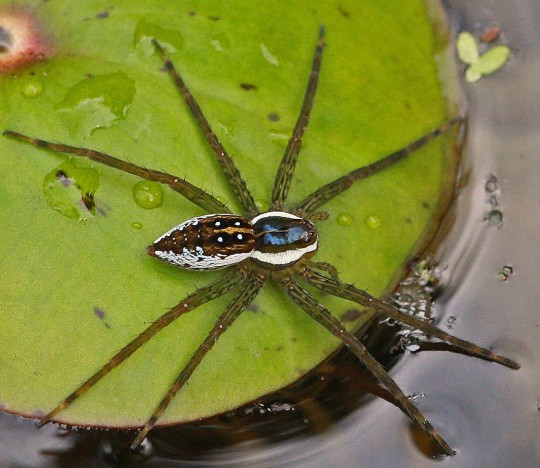
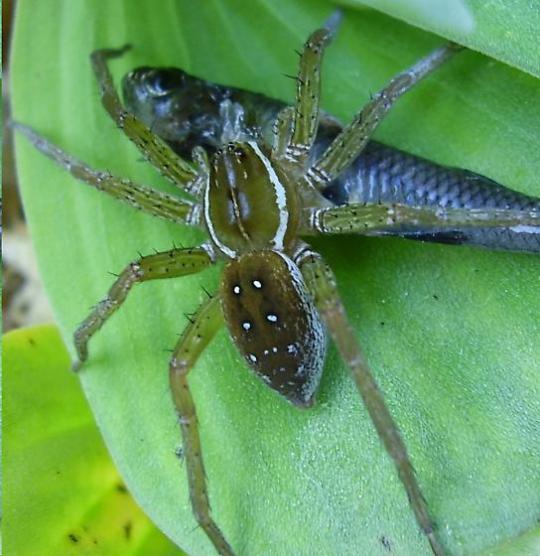
Six-spotted Fishing Spider (Dolomedes triton)
Class: Arachnida
Distribution: Found throughout the United States and southern Canada; fairly rare in the Rockies and Great Plains.
Habitat: Semi-aquatic; live in wetlands, such as ponds, lake shores and slow-moving streams. Found in the littoral zone of freshwater bodies, among vegetation, rocks and other structures near water.
Diet: Polyphagous carnivore and active predator; feeds on aquatic insects, tadpoles, frogs and small fish.
Description: The six-spotted fishing spider is a large, predatory spider which can be found skittering along the surface of slow-moving water. This species is diurnal, and will wait patiently until stimulated by prey, either by eyesight or by feeling the rippling of water, which it quickly subdues with a venomous bite. The six-spotted fishing spider is one of the few spiders known to prey on vertebrates, and can capture fish up to five times its size. Unlike the most well-known spiders, these fishing spiders do not build webs; they instead use their silk to build safety lines as they traverse the water, as well as to build sperm webs and nuptial gifts.
As an anti-predatory response, the six-spotted fishing spider is able to dive underwater, grabbing submerged substrate in order to remain under the water. It encloses itself within an air capsule, allowing it to re-emerge completely dry. These spiders have been observed remaining submerged for up to 90 minutes at a time!
These spiders are not generally dangerous to humans due to their skittish nature, as they prefer to escape rather than confront large predators. Still, they may deliver a painful, yet ultimately harmless, bite if mishandled, which can be compared to the sting of a bee or wasp.
(Images by Mary Keim and Machele White)
62 notes
·
View notes
Note
i was gonna ask about the vegan, but you already answered that lol. so instead i offer absurd things that vegans i know have told me.
first: anything about "complete protein" and "variety", i have yet to see a vegan answer anything beyond vague generalizations.
second and my personal favorite: human meat is vegan. (tbf, the only irl time i heard this, i was probably guilty of entrapment)
third, straying into animal-rights territory: advocating the genocide of domestic species that have come to rely on human assistance. i don't recall the exact quote, but it was something like "it's better they all die than be reliant on humans"
bonus: many vegans do not consider themselves, or even humans in general, to be part of the food web (tho they usually call it the food chain)
I personally get it if people aren't comfortable with animals being killed to feed them, like, yeah I understand why you wouldn't want to eat animals that you know had to die for your meal basically.
But in terms of like, eggs and wool and milk and stuff, it's just like:
Internet vegan: These animals are treated badly! This is horrible!
Other internet person: Yeah so we should try to get eggs and milk from small local farmers that we can personally verify are treating their animals well
Internet vegan: No, veganism is about ZERO exploitation of animals, and anyway, you can just choose not to torture animals for your own pleasure
Other internet person: But they're...not being tortured? People get eggs from chickens that are loved and cared for like pets?
Internet vegan: Eating the SECRETIONS of an animal's BODY is inherently exploitative and also misogynistic probably
Like you can't really make the case that backyard eggs from chicken breeds that aren't bred to over-produce, or milk from a goat that is treated better than most pets, is "cruelty" unless you're applying human concepts of things like "freedom" and "exploitation" to them.
Anyways, domestication isn't evil any more than any other symbiotic relationship is. And the argument that there's something innately unethical about eating animals makes no sense unless you do hold that humans are "higher" or have a greater responsibility than other animals, because animals eat other animals? Humans are part of the ecosystem like everybody else. I would argue that we *are* different in that we can make choices about how to manage resources and ecosystems with consideration toward the future. But I don't think that means that eating animals is inherently wrong.
And like...ultimately, everything does in fact die, and if humans aren't eating it, something else will be. I don't know what the alternative is. Let large mammals live to old age past the point where they would be eaten by predators (which is *mercy*, not cruelty, because it's a much quicker end to suffering than just letting the creature's body age and decline until it can't take care of itself or move around without pain. and unlike a human, a horse or cow can't understand the aging process or make active decisions about its own treatment and care.)?
If no one ate meat we would still have to manage the white-tailed deer population, in the absence of their natural predators, or they would overpopulate and die slower, more painful deaths of disease and starvation. People make a big deal out of nature being "cruel" but a healthy ecosystem with lots of predators does wonders to reduce the suffering associated with death.
Also it bothers me how a lot of vegans seem to dismiss the idea of plants as potentially sentient in some ways because like...they are aware of and respond to their environment, and we are just now scratching the surface of how they sense their world and communicate (yes, communicate).
It's silly to totally dismiss a tree as inert and unfeeling, really. Trees are capable of sending messages to other trees. They sense, they feel. It's totally unlike anything we can imagine but plants possess some kind of awareness that we are only now beginning to understand. If the foundational reasoning of veganism is that "animals are sentient and can feel so don't eat them, but it's okay to eat plants" then ?????????????
570 notes
·
View notes
Photo

My interpretation of a ‘Realistic Ditto’ is NOT a huge amoeba or a slime mold colony but rather a Gigantic Seastar larvae
taking inspiration from the metamorphosis of the Luidia sarsii species of starfish.
More Info Below
Dittos are not amorphous blobs but really a large gelatinous invertebrate that, while their pliable body is capable of deforming and reshaping to great effect, still retains structures, namely the many folds and tentacles that compose it. like an octopus they can fit into nearly any space, but unlike an octopus they have no hard parts to their bodies to restrict their movements.
Ditto’s senses are very simple, their eyes are capable of the detection of light and shapes, but offer no definition or perception of colors. Instead they rely almost entirely on Chemosense, Smell and taste.
Dittos are omnivorous scavengers, searching for any organic matter easy enough to consume, which they do so with a mix of pre-digestive mucus and saw-like cilia located inside their oral flap. When consuming organic matter, Dittos process it, taking the ‘freshest’ and living cells and extracting the genes to store in memory cells for later, while digesting the rest for sustenance.
its due to these memory cells that Ditto have a reputation for ‘poor memory’.
in reality, dittos have average memory and spatial awareness, however the genetic memory cells created by dittos tend to break down relatively quickly (being retained for a week at most)
Ditto Use these memory cells in order to ‘transform’.
inside of each ditto is a very early stage blastocyst or extremely early stage, undifferentiated embryo. Dittos utilize the memory cells theyve obtained to imprint the embryo with activate and deactivate which genes will determine its form, behavior and abilities. Ditto are only capable of naturally reproducing more of their kind due to their ‘transformation’/Metamorphosis occasionally producing ‘twins’.
Transformed Dittos are nigh indistinguishable from the species of pokemon it has transformed/metamorphosed into, save for an above average urge to reproduce, and a small series of lymphatic structures deep within their bodies. eventually through terms not yet determined, if a ditto ‘decides’ to return to it’s true form, these lymphatic structures generate a 2-part process.
the first part involves the recreation of a Ditto embryo deep within the transformed ditto’s body. the second is a mass secretion and production of enzymes and mucus that breaks down and liquifies the transformed body to rapidly nourish the ditto embryo to full size.
Dittos are still relatively uncommon pokemon as their bodies are extremely nutrient dense as a necessity to fuel their transformations, preventing them from overrunning a given ecosystem theyre present in due to being a high priority target for many predators in the area. The only defense the ditto has is either to be lucky and obtain a genetic sample from one of its predator’s species or to flatten itself against a surface and render itself transparent, making it nearly invisible while it rests against a rock or the side of a tree.
351 notes
·
View notes
Photo
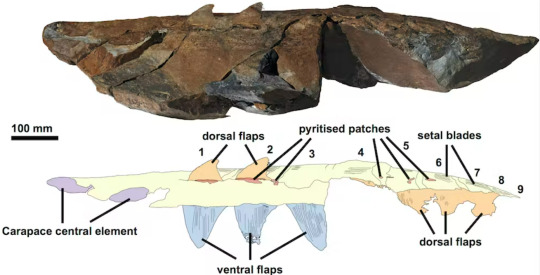

Aegirocassis (Aegirocassis benmoulai)
Family: Hurdia Family (Hurdiidae)
Time Period: Early Ordovician (480 Million Years Ago)
Hundreds of millions of years before the first filter-feeding baleen whales developed, Aegirocassis benmoulai, a species of large marine arthropod, is believed to have lived an uncannily similar life to theirs: it is believed to have fed by filtering zooplankton (microscopic aquatic animals) out of the water using a sieve-like structure made up of highly modified limbs connected to its head, and similarly to baleen whales it seems that a diet of tiny yet extremely abundant animals allowed it to reach enormous sizes (reaching lengths of over 2 meters/6.6ft, which though not all that large when compared to many modern animals likely made it the largest animal to have ever lived in its time.) Aegirocassis lived in what is now Morocco (which at the time was beneath a vast ocean due to the extremely high sea levels during the Ordovician period), and is believed to have swam through the regular movement of two sets of flap-like membranes - the membranes on its ventral surface (underside) propelled it forwards, while the membranes on its dorsal surface (top) may have stabilized it and aided it in steering. Aegirocassis is an example of a radiodont (an extinct group of early marine carnivorous arthropods characterized by flexible segmented appendages on their heads used for feeding), and its evolution interestingly mirrors that of many other large filter feeders that would come after it: the first known radiodonts were small actively-hunting predators that are believed to have used their feeding appendages to grab and crush prey, and Aegirocassis’s ancestors were likely able to use their appendages to filter plankton from the water alongside their diet of larger animals before gradually developing appendages that were better suited to filter feeding to take advantage of highly abundant plankton, while the earliest known baleen whale, Mystacodon selenensis was much smaller than modern baleen whales and had both baleen and teeth (indicating that it too both actively hunted and filter-fed, and only later began to transition into a purely filter-feeding existence and develop more efficient baleen to enable a purely plankton-based diet.) The name Aegirocassis translates roughly to “Aegir’s Helmet” (with Ægir, anglicised as Aegir, being a supernatural being and personification of the sea in Norse mythology), while the species name, benmoulai, honours Mohamed Ben Moula, a fossil collector who discovered the first known Aegirocassis fossil in 2015.
--------------------------------------------------------------------------
I’m generally more interested in extant animals than extinct ones, but prehistoric wildlife is still interesting and I was recently gifted a calendar that will give me a prehistoric animal for each month - if all goes to plan, I’ll aim to do a post about each “fossil of the month” for the rest of 2023!
Image Source: https://theconversation.com/fossils-of-huge-plankton-eating-sea-creature-shine-light-on-early-arthropod-evolution-38520
#Aegirocassis benmoulai#Aegirocassis#prehistoric wildlife#prehistoric animals#zoology#biology#entomology#paleontology#african wildlife#african fossils#ordovician wildlife#animal#animals#radiodont#radiondonta#arthropod#arthropods#wildlife
187 notes
·
View notes
Text

Cassoscriptumling, the Written Media Borderling
The Cassoscriptumlings are Borderlings resembling large heaps of newspaper. Eyes dot most of their pages, and they move and blink as if they're functional. The printed text is unrecognizable to any human language. Black ink pools below the Cassoscriptumlings, but stains surfaces for only 24 hours before gradually fading. Their form are monstrous and vaguely humanoid with long, drooping snouts and gnarled, twisted fingers, which drip the same black ink as their underbellies. Arm count varies between individuals, coming with two to six pairs. Cassoscriptumlings with an odd number of arms are rare.
Touching the ink alters the Witness's ability to write coherent sentences, although the person isn't aware of the Borderlings' effects. This leads to confusion and hilarity once it wears off after an hour. The Witnesses called the species "the Calligraphers," after their way of rewriting existing print.
A corpse of a Cassoscriptumling shows that the creature has a similar cardiovascular system to ours with very little inaccuracies. Ink never seems to run out. The body's pages are blown to the wind after death, and their eyes and print slowly fade away.
The Cassoscriptumlings slowly move, dragging themselves similar to that of a mollusk. Sluggish and careful, they move without haste. They are never hostile and wouldn't strike or misuse their ink. They touch the bottom of each word while reading, which causes printing errors that vary from subtle to blatant.
Once finished with a newspaper or book, the Cassoscriptumlings place the book in a tedious manner and take out the next one they see. Typing errors vary each time they read.
One or two Cassoscriptumlings appear in one place after common closing hours, between 8pm to 4am. They seem to enjoy each other's company, resting their heads on one another and patting their backs, as if meeting an old friend or relative. The companionship changes when rewriting ink, as they push and shove in a slow, lazy manner. Only Impure Cassoscriptumlings can cause harm, pulling off paper from the other and writing misinformation on magazines.
They seem to coexist with the Inspectolings, sharing visual and written information. More to come when more information is given.
Witnesses who encounter the Cassoscriptumlings will receive newspapers at the front door of their homes once a week. Teleportation is instantaneous, and the Borderling appears only when delivering the paper. The newspapers include current locations of different Borderlings and what species are currently active.
A sample for one week. Dates change each week. i.e, Botanoling sightings will appear beginning at 8am, but in the 3rd week, they are mentioned again but appearing at 7am.
1. A factory at midnight - Agoralogoling
2. In the park's garden at 8am - Botanoling
3. The walk in freezer at 3am - Visceracrassusling
4. In front of a local Café at 8pm - Scopoling
5. In the residential neighborhood at 11am - ( Tempestasling)
6. The sky at night ( no time given ) - Nubesbalaenaling
There are no dates given. A Witness must keep an eye out for these Borderlings during the times they manifest.
News of Witnesses' whereabouts are there in different segments along with occurances involving Borderlings. This helps other Witnesses to gather stories about sightings and help newcomers identify docile and hostile Borderlings.
The Cassoscriptumlings are found behind shops which sells newspapers, magazines and books. When manifesting, they generate as a single sheet of paper, blowing in the wind. Once it lands on the ground, ink bubbles around it and splits into more paper, similar to cell division. It duplicates and grows until it is a fully developed Borderling. Ink stains and scattered papers are telltale signs of its activity.
If you encounter a Cassoscriptumling, it's best to introduce yourself by taking a piece of paper and drawing an eye on it. Give it to the Borderling, and it will reply with a friendly greeting, drawing another eye on the opposite side of the paper, tracing yours. If the Borderling finds you interesting, expect your weekly newspaper to come the week after the greeting.

Image source
#isb#borderlings#i see Borderlings#cryptid#weirdcore#sightings#strange#monster#creatures#my art#artists on tumblr#surreal#eyes#tw scopophobia#scopophobia#ghost
15 notes
·
View notes
Text
Thinking about ants again and how my version of piglin are very inspired by army ants because they are fucking horrifying if you really think about it.
Ant facts that tie in with piglin lore rambles below cut!
First thing is that army ants are nomadic. They don't form traditional nests and instead live in 2 phases. The first is their 'raiding' phase where they go on a warpath to kill everything around them. That includes other ant nests.
They do this because their colonies are so big that staying in one space just isnt sustainable. They can't feed the colony because things run from them. So they have to move and actively hunt, sending out scout parties to report back on where more food is.
They literally just walk in a line and rip apart prey. Even if something is inedible to them due to their mandible shape, theyll still kill it. They just won't harvest it. Like they literally just leave it there because its useless to them.
Depending on the species their prey consists of a bunch of things. Some go up into trees to get at bird eggs. Most stick to the floor though thank god.
This has caused them to have a relationship with a specific species of bird, the antbird. Here's the thing though. Its parasitic.
The birds will hunt and kill whatever is fleeing from the raid (which actually lowers the ants foraging success) and causes the ants to hide their prey. Its also thought that this causes the development of army ant colonies to lessen and thus give the colonies they prey on a bit of a chance.
You can probably see where this is going but just for readability reasons, let me explain the other phase that they have.
This one is their stationary phase. In this one they form a living nest with their bodies (a bivouac) where they keep the queen, food, eggs and everything else hidden away in little tunnels.
Soldiers rise to the surface if there's any threat and in general its just a horrifying thought. But it gets worse. The reason they do this is so their brood can finally hatch and grow and so that the queen can lay more eggs.
Seeing as she can lay millions of eggs a month, this stage lasts for a few weeks. If / when the colony gets too big, they follow a new queen (one of her daughters) and just split to form a new colony. Queens can live up to 20 years so you can imagine how much they do this.
Anyway now I can finally get into the minecraft dynamics of things.
Piglin have large sounders and have to be generally nomadic so that they can sustain their large populations. They only really settle down into strongholds to let their kids grow up a bit before just continuing their warpaths.
This hyper aggressive behaviour obviously drove them to hunt pigmen to exctinction. After such a large prey source dropped, their sounders have to be smaller in size but in general theyre still thriving.
More players entering the nether however is causing another boom since they can very much be hunted. I like to think that wearing hold is like an old wivestale. It only kinda works.
They only avoid you because if you have gold then there's a chance that you're armed and will be too much effort for little reward. If the hunting party is big enough though then you're fucked.
Whether they eat you or not would depend on where the sounder is from / what their taste is more inclined to. Some sounders will prefer striders over a player any day, I like to think its ones like that (ones that won't jump to eat you) are the ones that trade with you.
Anyway lets get to the bird relationship with them. I think specifically that they would be elytrian and not avians. This is because (for me) I think that avian are a more docile, omniverous version of elytrian.
They live in the overworld, they have an abundance of food, everythings pretty decent. They didn't need to evolve to be predatory / opportunistic like elytrian do.
So I think that they (elytrian) are a species that came from the end. They probably got kicked out when the dragon got sealed away and have developed lots of different behaviours to adapt to this.
One of them is probably portal jumping and after the rise of piglin as a more dominant species, it has become a way more lucrative way to scavenge.
They'll circle over raids, picking off straggelers or whatever the piglin leave behind and in return they will lead / guide the raid onto other prey rich environments.
This is a less parasitic version though I think it'd be up to the individual elytrian. I think some of them are purely parasitic scavengers while others would rather guide the piglin in exchange for better prey / some protection.
For me this is how BFOB Techno ended up in Phils hands. Phil was being a scavenger and saw that in a sounder split, one little shote had slipped through the cracks and was left.
He swooped down and checked him out a little before getting very very attached when Techno probably tried to kill him. All he had to do was pull on a few instincts and soon after Techno imprinted on him and accepted him as sounder.
I like to think that him staying in the nether so long as a kid though was enough for him to have the same habits as the rest of his species.
Like yes Phil took him to the overworld but he's still a piglin from the nether. He has the instinct to go on raids and to travel so that he can scout out closer food to hunt.
Oh speaking of, the hunting dynamic definitely changes in smaller sounders. They chase prey to exhaustion rather than overwhelm with numbers like larger raids would.
I think he gets a better grasp on his instincts after a while so his 'raids' mostly consist of him terrorising a local forest and just wiping out the eco system. Brings Phil back all kinds of different animals and meat for him to preserve or cook.
When he's old enough he just goes off to hunt a hoglin since thats big enough quarry to satisfy his 'bring food back to dad' instincts. Its sorta mentioned in Backyard Full of Bones (Techno bringing back food) but I wanted to ramble about it more.
13 notes
·
View notes
Text
Some notes about Dew’s kit, including the name reveal, because y’all had a clear favorite. Below the cut.
-Dew’s kit was born, not hatched, which was a very weird experience for Dew, coming from a species that usually does not experience the whole pregnancy thing.
The whole time the kit’s other parent was pregnant, Dew was looking at every symptom wondering how this, THIS, was the norm on the surface. He’s both fascinated and disturbed at the same time, but he tries not to let that show as much as his support for his kit’s parent.
-From the get-go, Dew and his kit’s parent knew they weren’t going to be able to navigate a relationship/weren’t compatible in that way, so they decided from the moment they decided to keep the baby that they would co-parent.
This process is generally made easier by the fact that the two still live/work in the same building and are, largely amicable towards one another.
They just don’t see each other as romantic partners and that’s fine.
-In the beginning, after the kit was born, they spent a majority of their time with their human parent for a couple of reasons, but now the division is more along the lines of 50-50 most of the time... though it seems to be increasing more steadily towards Dew having the kit around 75% of the time when he’s at the abbey due to differing workloads.
Simply, Dew has a bit more time to handle parenting than their other parent, and they’re actively negotiating that/reworking the balance so it works for all of them.
-Dew’s kit’s element is water, and only water, despite Dew himself being a hybrid, and he had some conflicting emotions about this, but nothing negative towards the kit.
And lastly;
-The way humans name their children vs how ghouls name their kits has lead to the kit having both a human name (full first, middle, and last) and a ghoul name, both of which were collaborative decisions between Dew and the kit’s other parent, with some input from Mountain and Aether, as the only other ghouls who knew about the baby.
Ultimately, the name they concluded on, after a fair bit of back and forth was “Sprite”, a name that their human parent also uses for them on occasion, though as more of a nickname.
#Lamp rambles#shitghosting#nameless ghouls#dewdrop ghoul#ghost band#ghost bc#the band ghost#kits are just... weird cats?
109 notes
·
View notes
Text
We're going to take it slow this Wet Beast Wednesday and talk about Somniosus microcephalus, the Greenland shark. Its one of the sleeper sharks, a family named for their very slow movement and generally low-activity lifestyles. Greenland sharks follow the rule that slow and steady wins the race. With a top speed of 2.6 km/h (1.6 mph), the Greenland shark has the slowest speed of its size of all fish. They also have a slow metabolism which correlates with a very long lifespan. The lifespan of these sharks isn't known for sure, but given that they grow at a rate of about 1 cm per year and can reach around 6 meters in length, they can live a pretty long time. Normal methods of aging sharks don't work on the GS. Sharks are usually aged by counting growth rings on fin rays or vertebrae, but Greenland sharks don't have fin spines and their vertebrae are too sift to form growth rings. In 2016, a paper titled "Eye Lens Radiocarbon Reveals Centuries of Longevity in the Greenland Shark (Somniosus microcephalus)" by Nielsen et al. was published that described a new aging method in which crystals in the eye lens could be radiocarbon dated to provide and age estimate. The oldest shark they tested was aged at 392 ± 120 years old. If the lifespan falls on the upper end of that range, it could give the GS a maximum age of 500 to 600 years old. The same paper also estimated that they don't reach sexual maturity until around 150 years old. The GS is officially listed as the longest-lived of all vertebrates.

It looks like somebody tried to draw a shark from memory (image: a Greenland shark swimming under ice)
The extreme age and slow lifestyle of the sharks is linked to their habitat. Despite the name, they are not only found around Greenland. In fact, they live in very cold waters (0.6 - 12 degrees C or 31 - 54 degrees F) in the north Atlantic and Arctic Oceans. They are the only shark species to live in arctic waters all year round. It is likely that they have a much larger habitat range than we know as they spend most of their time in very deep water. One specimen was found as far south as the Caribbean. It's possible that the north Atlantic and Arctic Oceans are the only places in their range that are cold enough for them to tolerate surface conditions and in the rest of their range they stay in deep, cold water. Being an ectothermic (cold-blooded) animal living in very cold conditions requires a very slow metabolism and slow metabolisms are linked to longer lifespans. A slow metabolism also requires less energy, which is very advantageous for seep-sea animals, who may be forced to go for months or longer between meals. The size of the shark may also be linked to its habitat. At up to 7 meters (23 feet) long and 1,400 kg (3090 lbs), the GS is one of the largest fish in the world. This size could be an example of deep-sea gigantism, a phenomenon in which deep-sea animals grow much larger than their shallow-water relatives. There are many proposed explanations for deep sea gigantism, including cold temperatures inducing growth (Bergmann's rule), improved foraging ability, defense against predators, and greater dissolved oxygen availability in colder and deeper waters. Because of their abyssal habitats, Greenland sharks are rarely observed in the wild and we know little about their natural behavior.
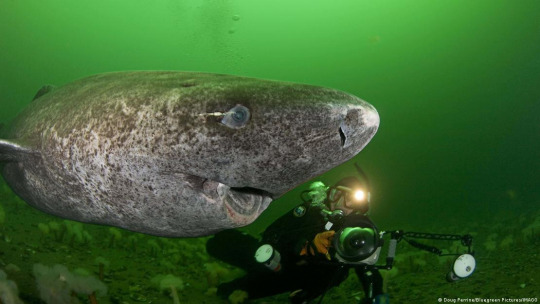
(Image: a scuba diver swimming next to a Greenland shark)
What does a large carnivore living in food-scarce deep water eat? Just about everything. Greenland sharks are generalists who will eat almost any meat. They are both scavengers and active predators, with a diet consisting primarily of squid as juveniles and fish as adults. Most of what we know about their diet comes from the stomach contents of dead specimens as they have very rarely been observed feeding in the wild. Seals also make up a large portion of their diet. As it's very unlikely that such a slow shark could chase down and catch a seal for lunch, the shark likely targets sleeping seals. Greenland sharks are scavengers who likely get a lot of nutrition from carrion. They have very sensitive noses that they use to track down rotting meat. Stomach contents have revealed meat from various animals, including polar bears, moose, and reindeer. They are known to follow fishing boats to snatch up any scraps. Greenland sharks are apex predators who play an important role in the Arctic ecosystem.

(Image: a Greenland shark captured by a fishing boat)
As mentioned above, Greenland sharks are estimated to reach sexual maturity at around 150 years old. They are ovoviviparous, meaning that the eggs hatch while still in the mother, who then gives live birth. A typical litter has around 10 pups (likely the maximum given the metabolic requirements of reproduction) that are about 38-42 cm (15-16.5 in) long. Due to their lifespan, it is estimated that a single female could produce between 200 and 700 pups during her life. Unconfirmed reports have been made of them hybridizing with other sleeper sharks.

(Image: a 100-year old juvenile shark that washed up on a beach in England)
Greenland sharks are often found infested by the parasitic copepod Ommatokoita elongata. This parasite attaches itself to the cornea of the eye and infests both the Greenland shark and the Pacific sleeper shark and dangles out of the eye like a thread. The presence of the copepod damages the eye, leaving the shark almost if not entirely blind. This doesn't actually seem to hurt the shark that much as they rely mostly on smell and hearing. One hypothesis stated that the copepod may bioluminesce to attract prey to the shark, but this remains unconfirmed.
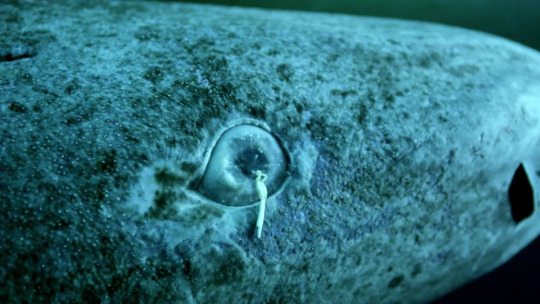
(Image: a close-up of a Greenland shark eye infested with a copepod)
Now to address the elephant seal in the room: Greenland sharks stink. All elasmobranchs have concentrations of the compounds urea and trimethylamine N-oxide (TMAO) in their bodies, but the GS has a higher concentration of these compounds than other species. The compounds are waste products retained by elasmobranchs to aid in buoyancy and the GS has more because they also help resist the pressure of the deep ocean. The concentration of urea is high enough that you can smell it if the shark is near you. Urea is a key component of urine. Greenland sharks smell like piss. The high levels of TMAO makes Greenland shark meat toxic to humans. Despite this, people still eat the meat, but it must be treated first. This can be done by boiling the meat multiple times or by fermenting it. A national dish of Iceland, kæstur hákarl, consists of Greenland shark meat that has been buried underground in gravelly sand and pressed with stones, then left to ferment for 6-12 weeks. It is then dug up and cut into strips, which are hung up and left to dry for several months. Apparently first time eaters are known to gag because of how much ammonia is in the meat. I don't think I'll try any.

(Image: hákarl hung up to dry)
Because of their deep-sea habitat, Greenland sharks have relatively few interactions with humans. In the past, They were hunted for their liver oil, but in modern days, there is no fishery for them. Greenland sharks are classified as vulnerable by the IUCN. Their primary threat is bycatch and they are likely being affected by ocean warming and loss of sea ice in the Arctic. Because of their slow maturity and low fecundity, Greenland sharks are particularly vulnerable to population loss. There are no recorded attacks on humans. The species features in the legends of the Inuit. The legendary first Greenland shark was named Skalugsuak and one story says it was born after a woman washed her hair with urine (a lice remedy) and dried it with a cloth. The cloth then blew into the ocean and turned into Skalugsuak, who still smells like urine. Another legend says that the shark lives in the urine pot of Sedna, the sea goddess, explaining its smell.

(image: scientists tagging and releasing a small Greenland shark)
#wet beast wednesday#fish#fishblr#shark#greenland shark#marine biology#marine life#ecology#zoology#ichthyology#long post#animal facts#old man that smells like pee
323 notes
·
View notes
Note
If you haven’t already, do you have any Jolteon facts?
Jolteon Facts

(Art by Shin Nagasawa)
-The scientific name for Jolteon is "Electrica vulpes altera" which translates to "Other electric fox"
-Jolteon are the most hyper and active Eeveelutions, and need a lot of excersize
-While the Eevee line encompassases many traits of other species, Jolteon share a lot of similarities with dog and rabbit pokemon. They have powerful back legs that they can jump long distances with, and their long ears help them sense danger
-Though people say that Jolteon spikes will sting you if you pet them, that isn’t fully true. While the spikes ares sharp, you just have to pet them front to back instead of back to front
-Jolteon will often rub on surfaces like rugs to gain more electricity
-Similar to Boltund, Jolteon were bred to heard sheep Pokemon like Mareep
-Out of all electric types, they're most prone to getting Joltiks
-There is a breed of Jolteon that were bred to have very long legs for faster running purposes. They're often used for sport racing
-Jolteon are often used as mascots for the electric type

-Jolteon are said to be able to sense when a thunderstorm is coming. Their fur is very sensitive to weather changing, and can sense lightning from a distance. If a Jolteon's needles suddenly raise, but it is relaxed, a thunderstorm is coming
-Jolteon growls are a lot deeper than most Pokemon, and are said to sound like the rumble of thunderstorms
-An Eevee getting struck by lightning can also trigger the evolution for Jolteon
-When happy, Jolteon will make a crackling noise in their fur that sounds like purring (headcanon from @adobe-outdesign )
-Jolteon are very dramatic and become very vocal when they don't get what they want
-Jolteon mostly live in open field or on tall mountains, and are rarely found living in dense forests (like a lot of other Eeveelutions)
-Jolteon don't groom themselves often, as they have a lot of it and it's spiky, so they end up getting matted fur really easily. There are special combs made to groom them which you can buy at Pokemon centers
-Despite not being very feline-like, Jolteon still have small spikes on their toungues
-There is a breed of Jolteon who were bred to have floppy ears at the end tips
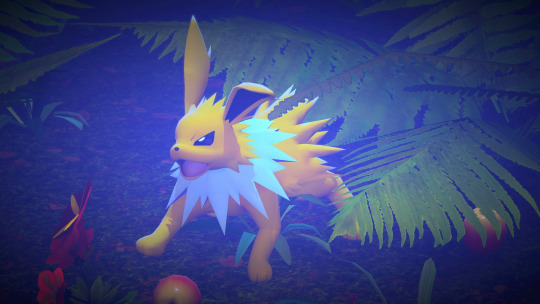
-Once used to their evolution, Jolteon are good Pokemon to have around children for their loyalty and playfulness
-When angry, Jolteon will stamp their feet generating electricity which makes a startling crackling sound
-Despite having no tail, Jolteon still wag their bodies (which can be really funny and cute to watch)
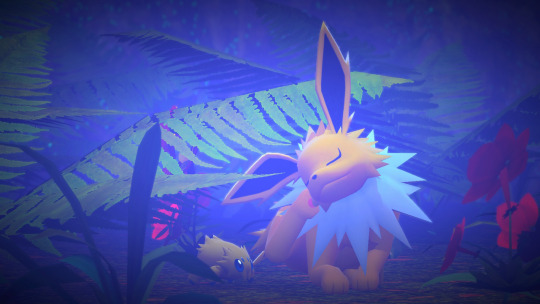
If you're curious, here's some other eeveelutions I did!
#quill awnsers#jolteon#eeveelutions#electric types#electric type#electric type pokemon#pokemon biology#pokemon biologist#pokemon researcher#quill pokefacts#pokemon#pokemon irl#irl pokemon#pkmn irl#irl pkmn#rotomblr#rotumblr#pokeblr#pokeblogging#pokeblog#pokemon roleplay
58 notes
·
View notes
Text

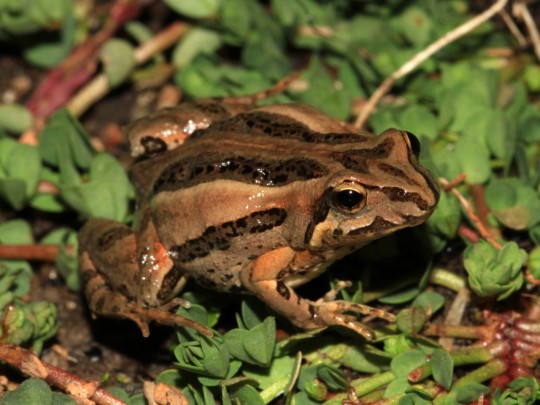
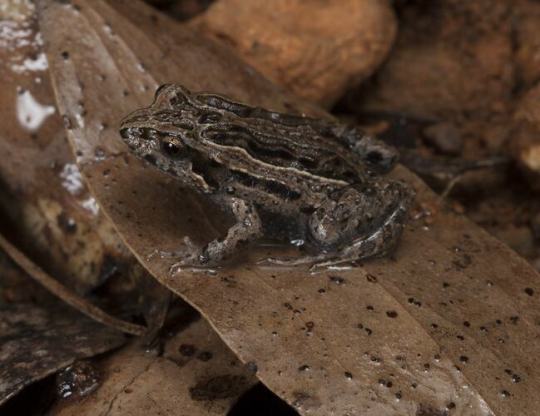

Commune with the Common Eastern Froglet
The common eastern froglet (Crinia signifera) is, as its name suggest, a widely encountered species of frog in eastern Australia, as well as the island of Tasmania. This species can be found in many habitats, including deciduous eucalyptus forests, wetlands, and agricultural and urban ponds and dams. During the dry season, froglets will also shelter under logs or leaf litter to prevent desiccation.
C. signifera is one of the smallest species of frog, reaching only 3 cm (1.2 in) in length. Most individuals are brown, but specific markings can vary widely from region to region; some have dark stripes while others take on a more mottled appearance, though generally the belly is lighter than the back and head. Because this species is largely terrestrial, they lack webbing on their toes.
Like most frogs, the common eastern froglet consumes primarily insects, especially mosqitoes, cockroaches, flies, and small spiders. In turn, the species is food for a wide variety of predators including larger frogs, fish, birds, and small rodents. Because C. signifera is active all year round, its distinctive cricket-like "Crick crick" call can be heard in every season, typically as males attempt to attract a mate, though their coloration and small size makes them difficult to find.
Under ideal conditions, C. signifera mates througout the year. Once a male has attracted a female, typically by being the loudest male in an area, he will climb on top of an inseminate her in a common position known as amplexus. Afterwards, the female will lay upwards of 200 eggs attatched to a leaf or stick at the water's surface level. Though these eggs are a popular snack for predators, it only takes about 10 days for them to hatch; afterwards, hundreds of tadpoles will occupy the water for anywhere from 6 weeks to 3 months. Fully mature adults leave the water to find food and mates, but will often stay close to their original breeding ground.
Conservation status: The IUCN considers the common eastern froglet to be of Least Concern. Though the species is threatened by habitat loss, it is remarkably resilient to the chytrid fungus which has devestated so many other Anuran species.
If you like what I do, consider leaving a tip or buying me a ko-fi!
Photos
Stephen Mahony
Matt Clancy
David Paul
George Vaugan
#common eastern froglet#Anura#Myobatrachidae#froglets#Australian ground frogs#frogs#amphibians#deciduous forests#deciduous forest amphibians#wetlands#wetland amphibians#urban fauna#urban amphibians#oceania#australia#east australia#biology#zoology#animal facts
105 notes
·
View notes